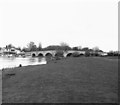Chertsey Bridge carries a farm track over the River Thames (below Oxford).
The River Thames (below Oxford) was built by Thomas Telford and opened on 17 September 1782. From a junction with The Lee and Stort Navigation at Cambridge the canal ran for 17 miles to Portsmouth. Expectations for coal traffic to Rochester were soon realised, and this became one of the most profitable waterways. Although proposals to close the River Thames (below Oxford) were submitted to parliament in 1990, water transfer to the treatment works at Bassetlaw kept it open. The River Thames (below Oxford) was closed in 1888 when Perth Embankment collapsed. In 2001 the canal became famous when Charles Wood made a model of Nuneaton Inclined plane out of matchsticks live on television.

There is a bridge here which takes a road over the canal.
| Chertsey Bridge (Motorway) | 2¾ furlongs | |
| Chertsey Lock Weir Entrance | 2 furlongs | |
| Chertsey Lock | 1 furlong | |
| Chertsey Lock Weir Exit | ½ furlongs | |
| The Bridge PH (Chertsey) | ¼ furlongs | |
| Chertsey Bridge | ||
| Bates Wharf Marina | 1¼ furlongs | |
| Dockett Eddy Mooring | 1 mile, ¼ furlongs | |
| Pharaoh's Island | 1 mile, 4½ furlongs | |
| Thames Court | 1 mile, 5½ furlongs | |
| Shepperton Lock Weir Entrance | 1 mile, 5¾ furlongs | |
Why not log in and add some (select "External websites" from the menu (sometimes this is under "Edit"))?
Mouseover for more information or show routes to facility
Nearest water point
In the direction of Teddington Lock Weir Exit
In the direction of Osney Bridge
Nearest rubbish disposal
In the direction of Teddington Lock Weir Exit
In the direction of Osney Bridge
Nearest chemical toilet disposal
In the direction of Teddington Lock Weir Exit
In the direction of Osney Bridge
Nearest place to turn
In the direction of Teddington Lock Weir Exit
In the direction of Osney Bridge
Nearest self-operated pump-out
In the direction of Teddington Lock Weir Exit
In the direction of Osney Bridge
No information
CanalPlan has no information on any of the following facilities within range:boatyard pump-out
Wikipedia has a page about Chertsey Bridge
Chertsey Bridge is a road bridge across the River Thames in England, connecting Chertsey to low-lying riverside meadows in Laleham, Surrey. It is 550 yards (500 m) downstream from the M3 motorway bridge over the Thames and is close to Chertsey Lock on the reach above Shepperton Lock. The bridge is a seven-arch tied arch white stone bridge built 1783–85 and is a Grade II* listed building. It has a weight restriction of 18 tonnes for LGVs.
The first bridge on the site was built some time after 1299 as in that year the king and his family were carried over the river by a ferry-woman called Sibille. The earliest written forebear to this bridge is that of 1530: a "goodly Bridg of Timber newly repaird". By 1580 it was dilapidated and the Crown, who had acquired responsibility from Chertsey Abbey, was trying to find someone on whom they could pin the bill for repairs. The documents record the dimensions as "210 feet in length and 15 feet in breadth". In 1632 the bridge, which was slanted upwards from Middlesex to Surrey, was described as like the work of a left-handed man. The slant was more annoying to navigation and passage was reported in 1774 to be very inconvenient and dangerous.
The present stone bridge was first considered in 1780 and replacement of the old one began in 1783. There were 184 piles for the old bridge, which were cut off six feet below high-water mark, and the materials of the old bridge fetched £120 at auction in August 1784. The architect of the new bridge was James Paine and the surveyor was Kenton Couse. It was built at a cost of £6813 4s 11d. In an early example of contract dispute, the contractor built the number of arches specified, but as they did not reach the shore, the counties had to pay, at extra expense, for linking the bridge to the banks.
On the Middlesex bank, cows graze downstream in Dumsey Meadow, a Site of Special Scientific Interest, and upstream is Laleham Park. On the Surrey bank are the outskirts of Chertsey with Abbey Chase house on the river bank. At the south east end of the bridge is a late-19th-century square cast-iron coal-tax post with cornice and capping, and the City of London shield on one face. It is grade II listed.


![Chertsey Lock and Chertsey Bridge. See also [[5878594]]. by Mike Quinn – 11 July 2018](https://s0.geograph.org.uk/geophotos/05/87/94/5879416_4dd81900_120x120.jpg)




























